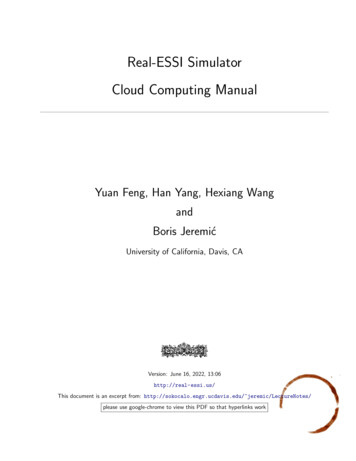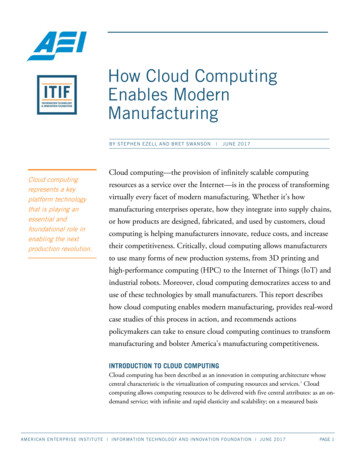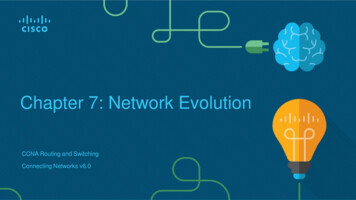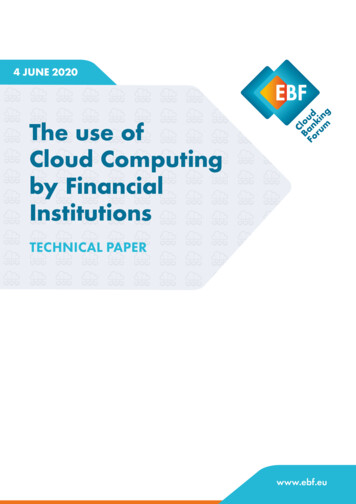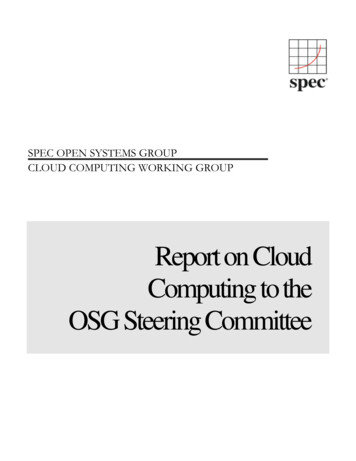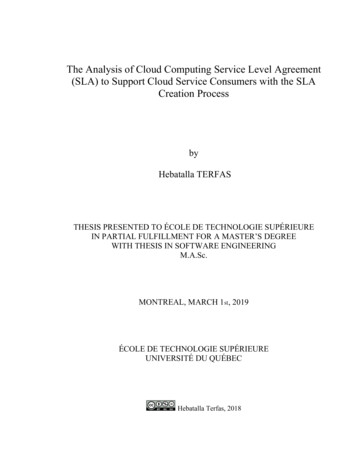
Transcription
The Analysis of Cloud Computing Service Level Agreement(SLA) to Support Cloud Service Consumers with the SLACreation ProcessbyHebatalla TERFASTHESIS PRESENTED TO ÉCOLE DE TECHNOLOGIE SUPÉRIEUREIN PARTIAL FULFILLMENT FOR A MASTER’S DEGREEWITH THESIS IN SOFTWARE ENGINEERINGM.A.Sc.MONTREAL, MARCH 1st, 2019ÉCOLE DE TECHNOLOGIE SUPÉRIEUREUNIVERSITÉ DU QUÉBECHebatalla Terfas, 2018
This Creative Commons license allows readers to download this work and share it with others as long as theauthor is credited. The content of this work can’t be modified in any way or used commercially.
BOARD OF EXAMINERSTHIS THESIS HAS BEEN EVALUATEDBY THE FOLLOWING BOARD OF EXAMINERSMr. Witold Suryn, Thesis DirectorSoftware Engineering & Information Technology DepartmentÉcole de technologie supérieureMr. Eric Paquette, President of the Board of ExaminersSoftware Engineering & Information Technology DepartmentÉcole de technologie supérieureMr. François Coallier, Member of the jurySoftware Engineering & Information Technology DepartmentÉcole de technologie supérieureTHIS THESIS WAS PRENSENTED AND DEFENDEDIN THE PRESENCE OF A BOARD OF EXAMINERS AND PUBLICJANUARY 29TH 2019AT ÉCOLE DE TECHNOLOGIE SUPÉRIEURE
ACKNOWLEDGMENTAt the beginning, I would like to thank my creator “Allah” who gave me the strength to gothrough this path and helped me to achieve my goals and dreams.I would like to express my deep appreciation to my research supervisor, Prof. Witold Suryn. Iam very thankful for the opportunity he gave me to work on this research and for his greatsupport and guidance through all the stages of this research.I also would like to thank my colleagues Jonathan Roy and Sara Moazzezi Eftekhar for theiroutstanding support and advices.Very special thanks to my family, my father who believed in me and supported me in everystep I took. For my mother who always encouraged me to be the best and do my best to reachmy goals, my brothers for their endless support and kindness.Extraordinary thanks as well to my husband and my children Jude and Zinedine who stayedby my side and supported me proudly through this journey. I am very grateful for thestrength and happiness they gave me. I dedicate this thesis to them as a proof of my love andappreciation.
Les analyses du niveau de service sur l’infonuagique (Cloud computing) pour aider lesutilisateurs de services l’infonuagique au processus de création de Contrat de niveau deserviceHebatalla TERFASRÉSUMÉLe l’infonuagique s'est développé rapidement ces dernières années. Les parties prenantes etplusieurs utilisateurs ont commencé à migrer leurs données vers le l’infonuagique pour tirerparti de son utilisation et de son stockage. La première chose que le fournisseur de servicesl’infonuagique(CSP) et les clients du service cloud (CSC) doivent traiter est l’accord deniveau de service (SLA). Il s’agit d’un accord conclu entre le fournisseur de service cloud etle client du service cloud, contenant les exigences du consommateur et le niveau de servicefourni par le fournisseur de services cloud. Le processus de création d'un contrat de niveau deservice est essentiel pour les fournisseurs de service de l’infonuagique et les consommateurs.Cependant, cela pourrait être vague et pas bien défini. Pour améliorer l'utilisation de tous lesservices de l’infonuagique, le contenu et la création de l'accord de niveau de service doiventêtre gérés de manière efficace et prudente.Dans cette thèse, nous avons d’abord effectué une revue de littérature pour vérifier le niveaud’occurrence des paramètres SLA et l’objectif de niveau de service SLO dans le mondeuniversitaire et générer une liste des paramètres SLA et SLO les plus et les moins étudiés.Dans le deuxième chapitre, nous avons confronté cette liste aux trois fournisseurs de servicesde l’infonuagique les plus populaires du marché moderne (Amazon, Microsoft et Google)afin d’enquêter sur la couverture de leur contrat de niveau de service.Enfin, dans le dernier chapitre, nous avons proposé un outil SLA qui pourrait aider lesfournisseurs de service cloud et les consommateurs dans le processus de création de SLA.Cet outil SLA aiderait les consommateurs tout au long de la phase de négociation etfaciliterait le processus de selection, afin de choisir le fournisseur de service le plus adapté.Mots-clés: L’infonuagique, Contrat de niveau de service (SLA), Objectif de niveau deservice (SLO), Cycle de vie du SLA, Phase de négociation du SLA.
The Analysis of Cloud Computing Service Level Agreement (SLA) to Support CloudService Consumers with the SLA Creation ProcessHebatalla TERFASABSTRACTCloud computing has been developing rapidly in the past few years. Stakeholders and severalusers started to migrate their data to the cloud to benefit from its usage and storage. The firststep cloud service provider (CSP) and cloud service consumers (CSC) deal with is the servicelevel agreement (SLA). It is an agreement issued between the cloud service provider and thecloud service customer that contains the consumer’s service requirements and the servicelevel provided by cloud service providers. The process to create an SLA agreement is veryessential for both cloud service providers and consumers. However, it could be vague and notwell defined. To enhance the usage of any cloud services, the content and the creation of theSLA agreement should be handled efficiently and carefully.In this thesis, first we conducted a literature review to check the level of occurrence of SLAand SLO parameters in the academia and generate a list of the most and least studied SLAand SLO parameters. In the second chapter, we confronted this list to the three most popularcloud service providers in the modern market (Amazon, Microsoft and Google) to investigatetheir SLA agreement coverage.Finally, in the last chapter, we proposed an SLA toolkit that could assist cloud serviceproviders and consumers in the process of SLA creation. This SLA toolkit would help theconsumers through the negation phase and facilitate the selection process to choose the mostapplicable cloud service providers’ offer.Keywords: Cloud computing, Service level agreement (SLA), Service level objective (SLO),SLA life cycle, SLA Negotiation phase.
TABLE OF CONTENTSPageINTRODUCTION.1CHAPTER1 LITERATURE REVIEW . . . .31.1SLA parameters distribution .31.1.1Extracted SLA parameters . 31.1.2Literature review methodology . 61.2SLO parameters distribution .161.2.1Extracted SLO parameters . 16CHAPTER 22.12.22.32.4CONFRONTING CLOUD SLA AND SLO PARAMETERS’ LISTS WITHMOST POPULAR CLOUD SERVICE PROVIDERS IN THE MODRENMARKET .25Introduction .25Cloud computing providers’ SLA offers .272.2.1Amazon . 272.2.1.1 Amazon S3 SLA . 282.2.1.2 AWS customer agreement . 292.2.1.3 AWS service terms . 292.2.2Microsoft . 302.2.2.1 SLA for storage . 312.2.2.2 Microsoft Azure agreement . 332.2.3Google . 342.2.3.1 Google cloud storage SLA . 342.2.3.2 Google cloud platform terms of service. 352.2.3.3 Google service specific terms . 38The comparison between the extracted SLA and SLO lists and modren cloudproviders SLA offers.392.3.1Modern cloud providers SLA offers and the extracted SLA parameters’list. 392.3.1.1 The criteria used in the comparison between cloud serviceproviders’ SLA offers and the extracted SLA parameters. . 392.3.2Modern cloud providers’ SLA offers and the extracted SLO parameters’list. 422.3.2.1 The criteria used in the comparison between cloud serviceproviders’ SLA offers and the extracted SLO parameters. . 42Observations and conclusion .45CHAPTER 3PROPOSED SLA TOOLKIT . 493.1Cloud computing SLA life cycle .493.2SLA toolkit.503.2.1How Does it work . 513.3Conclusion .55
XIICONCLUSION .57RECOMMENDATIONS.59ANNEX I SLA AND SLO PARAMETERS EXTRACTION.61ANNEX II SLA AND SLO OCCURANCES PERCENTAGES.87BIBLIOGRAPHY.103
LIST OF TABLESPageTable 2.1Microsoft Storage Extracted SLA Parameters .32Table 2.2Google Cloud Platform Term Extracted SLA parameters .35Table 2.3The Comparison of Most Studied SLA Parameters and Cloud Providers .39Table 2.4The Comparison of Most Studied SLO Parameters and Cloud Providers .43
LIST OF FIGURESPageFigure 1.1SLA Parameter Extraction Process .7Figure 1.2SLA Parameters Distributions Chart .9Figure 1.3SLA Parameters’ Distribution Part1 .11Figure 1.4SLA Parameters’ Distribution Part 2 .14Figure 1.5SLO Parameters Distribution Chart .17Figure 1.6SLO Parameters’ Distribution Part 1 .19Figure 1.7SLO Parameters’ Distribution Part 2 .22Figure 3.1Classic SLA management Life Cycle . .49Figure 3.2SLA Parameters Identification Form .52Figure 3.3SLA Toolkit Work Process .53
LIST OF ABBREVIATIONS AND ACRONYMSAWSAmazon Web ServiceCCCloud ComputingCSCCloud Service ConsumerCSPCloud Service ProviderIaaSInfrastructure as a serviceKPIsKey performance IndicatorsPAYGPay As you Go Cloud computingPaaSPlatform as a serviceQoSQuality of ServiceQRsQuality RequirementsRTORecovery Time ObjectiveSLAService Level AgreementSLOService Level ObjectiveSLService levelSaaSSoftware as a serviceS3Amazon Simple Storage Service
INTRODUCTIONConsidering the several advantages cloud computing is providing for users such as reductionin cost and elastic resources, etc., it is rapidly taking over traditional IT infrastructure andmany business stockholders, government and academia nowadays are transforming anduploading their work to the cloud. It is a wide field that researchers keep working on toimprove the level of quality provided.The first step cloud service consumers face when subscribing to a cloud service is Servicelevel agreement (SLA). It is a contract issued between cloud service provider and consumerthat should specify the service level requested by cloud service consumers and identifies theirrequirements (Terfas, Suryn, Roy & Moazzezi Eftekhar, 2018, P.2). Having a well-structuredSLA could lead to a better service level and less service violations. However, “One openproblem is that service level agreements (SLAs) in the cloud ecosystem are yet to mature to astate where critical applications can be reliably deployed in clouds” (Faniyi & Bahsoon,2015, P.1). Therefore, several researches are conducted to improve the SLA structure andfacilitate the creation process. Although many researchers tried to simplify the use and theinitiation of an SLA, they didn’t focus enough on SLA and SLO parameters, which couldlead us to a poor SLA agreement that contains only useless and impractical words. Accordingto Faniyi, most of the studied papers in their research discussed only one to three SLAparameters rather than the rest of cloud service parameters (Faniyi & Bahsoon, 2015, P.2). Inthis research, we deeply analysed several papers from the literature to find out the most andleast studied SLA and SLO parameters that cloud service consumers would use during theSLA creation.Another unsolved problem is that cloud service providers define SLA and SLO parametersin advance so they don’t respect all users’ requirements (Rady, 2012, P.9). Consequently, wedeeply investigate three well-known cloud service providers (Amazon, Microsoft andGoogle) and confront their SLA agreements to the SLA and SLO list extracted from theacademia to check the level of coverage they offer in their SLA.
2SLA life cycle consists of several stages that start with the negotiation stage. At this stage,cloud service consumers have to choose the most appropriate cloud service provider thatadheres to their requested requirements. However, SLA creation process and cloud providerselection could be complicated, difficult to follow and time consuming. In this research weproposed an SLA toolkit that could help both cloud service provider and consumer. ThisSLA toolkit could facilitate the negation process and help the consumer in the process ofcloud provider’s selection. In addition, it could help cloud service consumers gain morecontrollability over their data to increase the level of trust towards cloud computingenvironments.Thesis structureThis thesis is structured as the following: the first chapter presents a literature reviewconducted to show the SLA and SLO parameters distributions in the academia and to identifythe most and least studied SLA and SLO parameters. Chapter two illustrates the selectedcloud service providers and confronted them to the extracted SLA and SLO parameters’ liststo show the coverage percentage for each cloud service provider. Chapter three presents theproposed SLA toolkit and how it works to assist cloud service providers and consumersthorough the process to create an SLA agreement. Finally, we conclude our thesis andpresent our future research plan.
CHAPITRE 1LITERATURE REVIEWIn this chapter, we present a list of SLA and SLO parameters that were extracted from ISOstandards 19086 and the literature. We demonstrate the occurrence percentages for all thepresented SLA and SLO parameters to identify the most and the least studied SLA and SLOparameters in the academia.1.1SLA parameters distribution1.1.1Extracted SLA parameters“Service level agreement (SLA) is a contract signed between the customer and the serviceprovider. It states the terms of the service including the non-functional requirements of theservice specified as the quality of service (QoS), obligations, service pricing, and penalties incase of agreement violations” (Emeakaroha, Brandic, Maurer & Dustdar, 2010, P.1). From aquality point of view, SLA consists of several agreements, which are combined into onecontract. These agreements are based on different facts such as nature, cost and objectives ofthe provided service. Additionally, it can contain the number of violations that are allowedduring a predefined period of time. (Mirobi & Arockiam, 2015, P.3).Nowadays, several factors are encouraging stakeholders to migrate their data to the cloud.However, there are many unsolved issues which could slow down the process. One of theissues that cloud service consumers face when they plan to move to the cloud is that cloudcomputing service level agreement (SLAs) are not reliable enough to support the deploymentof their crucial applications (Faniyi & Bahsoon, 2015, P.1), Although, InternationalOrganization for standardization (ISO) has developed ISO/IEC19086 cloud computingService level agreement (SLA) framework, only ISO/IEC 19086 part 1 and 3 are publishedwhile ISO/IEC19086 part 2 and 4 are still under development.
4Also ISO/IEC 20000 series was developed to support IT service management. It identifiesdifferent requirements to support service management systems SMS. It consists of 11 parts.ISO/IEC 20000-9 focuses on cloud services and provides a guideline to facilitate the usage ofISO/IEC 20000-1 for cloud services by proposing some scenarios that can help both cloudservice providers and consumers. However, service level agreement was only mentioned as atool to ensure the quality of the service and did not include any SLA or SLO parameters thatcould be useful in the SLA creation process. Regarding service level agreement SLA,ISO/IEC 20000 defines SLA as a document that includes service requirements and servicetargets. According to ISO/IEC 20000, one or more service level agreements SLAs could becreated for each IT service. In addition, SLAs should be updated according to anyrequirements change. According to Zitek, “ISO/IEC 20000 defines SLA as a mandatoryrequirement as one of the service delivery process” (20000Academy, 2015). ISO/IEC20000specified some recommendations and conditions which could apply for service managementsystems SMS process that includes some SLA contents and conditions which could beconsidered in an SLA contract. However, no SLA or SLO parameters were suggested orproposed. Therefore, it was not considered in this analysis due to the shortage use andconsideration of SLA and SLO parameters.Meanwhile, information technology infrastructure library ITIL consists of best practicescollection that could be used for IT service managements. It can help organizations byimproving the delivery of IT services. Service level agreement SLA were discussed in ITIL,only in two core areas service design and continual service improvement to cover any serviceupdates that can affect the SLA. Based on Zitek, ITIL defines SLA in the scope of the servicelevel management process and specifies other types of agreements that could be used besidesSLAs such as operational level agreement (OLA) and underpinning contract (UC)(20000Academy, 2015). In addition, it provides guidance that could help providers andconsumers in the initiation process of an SLA. For example, the responsibilities of providersand consumers should be well defined in an SLA contract. Also a single SLA could be usedby various consumers for several IT services (Morin, Aubert& Gateau, 2012, P.4). ITILassists organizations to know the value of their IT services to help understanding the
importance of this value to define a better SLA. However, ITIL is not totally focusing onobtaining this (Wegmann, Regev, Garret &Maréchal, 2008, P.1). Therefore, ITIL do notprovide any SLA or SLO parameters to help in the definition of an SLA. Even though ITILprovided several recommendations regarding the SLA creation, it did not include any SLAand SLO parameters that could be helpful to use in an SLA and in this research analysis.Cloud computing SLA is still suffering from an obvious lack of standardization. In spite ofthe fact that there are a wide variety of papers on SLA in the academia, only few of themdiscuss SLA parameters. As shown by Faniyi & Bahsoon in their systematic survey, theydemonstrated that only one to three SLA parameters were mentioned in the greater part of theanalysed articles, while only a few articles considered four to five SLA parameters (Faniyi &Bahsoon, 2015, P.7).We conducted a literature review to extract the most studied SLA parameters in the academiaand create a list of the most frequently mentioned SLA parameters. This list would helpanalysing and verifying the applicability of SLA contracts for (Amazon, Google andMicrosoft) in the modern market.
61.1.2Literature review methodologyIn this research, we used several research engines such as Compendex, IEEE Xplore andGoogle Scholar to look for articles concerning this topic. By using multiple related keywordsand some questions, related articles were found and analysed. Some keywords that were usedare cloud computing Service level agreement SLA, quality aspects, SLA parameters, SLAchallenges, SLA initiation and SLA Frameworks.The following research questions were investigated:Q1: What are the SLA parameters that should be covered in cloud computing SLAs?Q2: What is Service Level Agreement?Q3: What is the state of cloud computing SLAs today?To answer the above mentioned questions, we conducted a literature review and the mostrelevant articles were investigated. However, only the applicable ones were selected. At thebeginning of this research, 40 articles were found in this area. By carefully scanning theabstracts, only 25 were selected and finally after reading all of these articles individually,only 19 included the required information for this research analysis. Many of the consideredpapers proposed SLA frameworks. SLA and SLO elements were discussed and used toprove the applicability of their frameworks, while other articles discuss only SLA definitionand its importance in the industry. Due to the limited research papers on this area (SLA) a lotof the chosen papers were conference papers. Articles take longer time to be published.Furthermore, conference papers are more up to date.
Figure 1.1 SLA Parameter Extraction ProcessAs shown in figure 1.1 stage 3, these are the variables definitions: Let (F) be the percentage of the frequency of SLA parameters.Let M(n) be the number of how many times each parameter was mentioned across all thearticles.(when the parameter is mentioned one time or more in each article, it is considered as 1)Let A(n) be the total number of the analysed articles.(n): means the total number. For example, A(n) is the total number of the analysed articlesAs seen in Figure 1.1 SLA parameters extraction process consists of 4 steps:Step.1: The literature review was conducted; SLA parameters were extracted from severalarticles that were found in the academia.Step.2: A table for each article was created. It includes SLA and SLO parameters that werefound in each reference.
8Step.3: After the duplicated parameters were eliminated, the next step was to check theoccurrences for each SLA parameter in all the provided references. For further details, pleaserefer to the tables in Appendix I and II. As shown in appendix I and II, M (Mentioned) waschosen when the SLA parameter was mentioned while NM (Not Mentioned) was chosenwhen the parameter was not mentioned in the reference.Step.4: After applying the above mentioned steps to all extracted SLA parameters, theoccurrence percentage was calculated using the following equation:F M(n) X 100A(n)Where F is the distribution percentage of the SLA parameter in the academia, a percentagefor each SLA parameter was identified. Based on this, the list of the most frequently usedSLA parameters in the academia was created. In addition, a chart was drawn to show thehighest and the lowest percentage of the parameters and to clarify the distribution for the restof the SLA parameters.NOTE: This methodology was also used to create the list of the extracted SLO parameters.
The following chart (figure 1.2) shows the most studied and least studied SLA parametersfound in the academiaFigure 1.2 SLA Parameters Distributions ChartAfter classifying the extracted SLA parameters and identifying the percentage of theirdistribution, we have indicated that these SLA parameters which are presented in figure 1.2were found in the literature and used or defined by a variety of researchers. After extractingSLA parameters from the literature, we calculated their occurrence percentages as shownpreviously to find out the frequency percentage for each parameter and how many times it
10was mentioned. Based on this, the criteria used to identify the most and least used SLAparameters was that parameters with the highest percentages were considered as the moststudied SLA parameters in the literature while parameters with the lowest percentages wereconsidered as the least studied SLA parameters. Overall, the bar graph illustrates thepercentage of occurrence for the SLA parameters according to their distributions in theacademia.The chart consists of 41 SLA parameters. The highest occurrence percentage is 68% and thelowest is 5%. Looking in closer detail at the chart it can be seen that availability and securityare on the top of the graph. They were the most studied SLA parameters in the academia andhave the highest percentage among all other extracted parameters, while response time andperformance came right after them with a percentage of 57% and 52% respectively.On the other hand, some SLA parameters such as (Service Excess Use, Data deletion,Agility and Error rate) have the lowest occurrence percentage. Therefore, they are consideredas the least studied SLA parameters.This list of SLA parameters support cloud service consumers and providers with the mostprominent SLA parameters to be analysed and discussed when creating a user-tailored SLAfor cloud service consumers. In addition, in the modern market, providing cloud serviceconsumers with longer list of parameters would help to persuade cloud service consumersand encourage them to move to the cloud (Suryn, 2013, P.152).To simplify this analysis and explanation, we divided the chart in figure 1.2 into two chartsand illustrated them individually.
Figure 1.3 SLA Parameters’ Distribution Part1As shown in figure.1.3, the bar graph shows the SLA parameters that were derived fromseveral articles in the academia such as (Faniyi & Bahsoon, 2015), (San & Irena, 2016) &(Ghosh & Ghosh, 2012), etc., where they were mentioned as critical SLA parameters to cloudservice consumers. By closely observing the graph, it can be seen that availability andsecurity are mentioned frequently often, when comparing them to other the SLA parametersin the reviewed papers, while service violation, storage and role and responsibility got lessconsideration and were at the bottom of the chart.In following paragraphs the definitions of some extracted SLA parameters are presented,addressing the sources, where they were discussed and derived from. The upcoming SLAparameters were selected based on their order and percentage in the chart in figure 1.3. Weillustrated the SLA parameters with different percentages to show the variety among thesepresented percentages.
12SLA parameter 1 (Availability). According to ISO/IEC 17788 cloud computing standard“Availability is the property of being accessible and usable upon demand by an authorizedentity”. This SLA parameter clarifies to the user that the requested service is easy to accessand usable in a certain period of time. A new SLA framework for E-commerce cloud servicewith respect to the end user perspectives was proposed by (Busalim, Hussin & Ibrahim,2013, P.1). They provided a list of the most applicable SLA parameters and their objectives.Availability was on the top of this list. “Most of cloud service provider’s focus only on smallset of parameters, namely availability, request completion rate and response time”. (Busalimet al., 2013, P.3). In accordance with Frey, to encourage cloud service consumers to movetheir data to the cloud, an individual SLA agreement should be build according to therequirements of each requested service rather than having a standard SLA for all cloudservice consumers neglecting their different needs (Frey, Luthje, Teckelmann& Reich,2013,P.1). They illustrated a machine processed Adaptable Service Level Objective Agreement(A-SLO-A). They also suggested that Availability is one of the critical SLA parameters to beincluded when creating an SLA agreement to suit the requirements of different cloud serviceconsumers.SLA parameter 2 (Security). Security is another issue that cloud service consumers andproviders have to deal with. It is a vital SLA parameter that is recommended to be consideredwhen creating an SLA contract. ISO/IEC 19086 part 4 discusses security and privacy incloud computing. As indicated by (Ghosh & Ghosh, 2012, P.3 ), to assure the security of datatransitions from and to the cloud, SLAs should consider security as a crucial element.Considering the difficulties cloud service consumers face when choosing the appropriatecloud service pro
level agreement (SLA). It is an agreement issued between the cloud service provider and the cloud service customer that contains the consumer's service requirements and the service level provided by cloud service providers. The process to create an SLA agreement is very essential for both cloud service providers and consumers.






